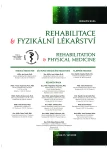Evaluation of Syndrome Frailty in the Framework of Physical Ability of Seniors
Authors:
A. Hudáková 1; Ľ. Majerníková 1; A. Obročníková 1; L. Džurňáková 2
Authors‘ workplace:
Katedra ošetrovateľstva, Fakulta zdravotníckych odborov, Prešovská univerzita v Prešove
1; ADOS, ŠIAS, s. r. o., Stará Ľubovňa
2
Published in:
Rehabil. fyz. Lék., 27, 2020, No. 3, pp. 156-163.
Category:
Original Papers
Overview
Introduction: The aim of the thesis was to find out how much frailty syndrome effects mobility and other factors as self-sufficiency, nutrition of elderly people.
File and methods: The average age of men was 74 years and in women was 76 years. The inclusion criteria for the selection of the sample were: age over 65 years, cognitive disposition and consent to inclusion in the research. We used a set of three standardized questionnaires: Short Physical Performance Battery (SPPB); Nottingham Screening Tool (NST); Activity Daily Living (ADL).
Results: A small group of seniors (17%) belonged to the group pre-frailtly according to the SPPB test Only 22% of men and 11% of women had good physical fitness at the age of 75-89 years. Good nutritional status was recorded in 38% of people aged 65-74 years, in 19% of seniors in the range of 75-89 and in 6% of long-term seniors. Complete self-sufficiency (ADL test) was achieved by 15 seniors under the age of 89.
Discussion and Conclusion: The results of the SPPB test used confirm the fact that the incidence of frailty increases with age. SPPB is sensitive enough to detect frailty syndrome. Inadequate food intake can affect the functional condition of the senior. Exercise is suitable for the treatment of frailty itself, especially strengthening with a visible anabolic effect. Short-term isometric exercises that do not burden the cardiovascular system are appropriate.
Keywords:
nutrition – frailty – assessment – self-sufficiency – exercises
Sources
1. BERKOVÁ, M.: Krátká baterie pro testování fyzické zdatnosti seniorů – pilotní studie a verifikace testu u starších osob v České republice. [online] Vnitřní lékařství, 59, 2013, 4 [cit. 2019.09.02]. Dostupné z: https://www.prolekare.cz/casopisy/vnitrni-lekarstvi/2013-4/kratka-baterie-protestovani-fyzicke-zdatnosti-senioru-pilotni-studie-a-validizace-testu-u-starsichosob-v-ceske-republice-40572.
2. BODÁKOVÁ, D.:Frailty syndróm – charakteristika. Solen, 2011, 4, s. 52-54, [online]. [cit. 2019/10/20]. Dostupné z: http://www.solen.sk/index.php/index.php?page=pdf_view&pdf_id=5244&magazine_id=13.
3. BORIKOVÁ, I.: Posudzovanie aktivít denného života. Ošetrovatelství a porodní asistence, 1, 2010, s. 24-30. ISSN 1804-2740.
4. CLEGG, A. et al.: Frailty in elderly people. Lancet, 381, 2013, s. 752-762.
5. CROGAN, N. L., PASVOGEL, A.: The influence of protein-calorie malnutrition on quality of life in nursing homes. J Gerontol A Biol Sci Med Sci, 58, 2003, 2, s. 159-164.
6. FERRUCI, L. et al.: Biomarkers of frailty in older people [online]. 2002. [cit. 2020.02.18]. Dostupné z: https://www.ncbi.nlm.nih.gov/pubmed/12508906.
7. GURALNIK, J. M., FERrUCI, L., PIEPER, C. F., LEVEILLE, S. G., MARKIDES, K. S., OSTIR, G. V. et al.: Lower extremity function and subsequent disability: consistency across studies, predictive models, and value of gait speed alone compared with the short physical performance battery. Journals of Gerontology, 55, 2000, 4, s. 221-231.
8. HEGYI, L., KRAJČÍK, Š.: Geriatria. Bratislava, Herba. 2010. ISBN 978 - 80 - 89171-73-6.
9. HOOZOVÁ, J.: Krehkosť: spoločná téma geriatra a paliatológa. Onkológia [online], 9, 2014, 6, s. 349-354. ISSN 1339-4215. [cit. 2019.01.20]. Dostupné z: http://www.solen.sk/pdf/a42afdf15409c6c1bdc17a4de8212fe7.pdf.
10 HUDÁKOVÁ, A. et al.: Geriatrické syndrómy ako prediktory ošetrovateľstva v geriatrii. Prešov, Fakulta zdravotníckych odborov Prešovskej univerzity v Prešove, 2016, 192 s. ISBN 978-80-555-1749-0.
11 HUDÁKOVÁ, A., OBROČNÍKOVÁ, A.: Disabilita a frailty - nové fenomény v geriatrii. Sestra a lekár v praxi, 11, 2009. 8, s. 42-43, ISSN 1335-9444.
12 KALVACH, Z, HOLMEROVÁ, I.: Geriatrická krehkosť – významný klinický fenomén. Medicina pro praxi [online], 5, 2008, 2, s. 66-69. ISSN 1803-5310. [cit. 2019.11.12]. Dostupné z: https://www.medicinapropraxi.cz/pdfs/med/2008/02/05.pdf.
13. KLEVETOVÁ, D., DLABALOVÁ, I.: Motivační prvky při práci se seniory. Praha, Grada, 2008. ISBN 978-80-247-2169-9.
14. LIPPERTOVÁ-GRÜNEROVÁ, M.: Neurorehabilitace. 1. vyd.m Praha, Galén, 2005, 350 s. ISBN 80-726-2317-6.
15. MORLEY, J. E.: The frailty syndrome: Definition and natural history [online]. 2011. [cit. 2019-11-29]. Dostupné z: https://www.geriatric.theclinics.com/article/S0749-0690(10)00083-2/fulltext.
16. NÉMETH, F., DERŇÁROVÁ, Ľ, HUDÁKOVÁ, A.: Komplexné geriatrické hodnotenie a ošetrovanie seniorov. Prešov, Fakulta zdravotníckych odborov Prešovskej univerzity v Prešove, 2011, 216 s. ISBN 978-80-555-0381-3.
17. PERI, K., KERSE, N., ROBINSON, E., PARSONS, M., PARSONS, J., LATHAM, N.: Does functionally based aktivity make a diference to health status and mobility? A randomised controlled trial in residential care facilities. Age and Ageing, 37, 2008, 37, s. 57-63.
18. POKORNÁ, A.: Komunikace pro seniory. Praha, Grada, 2010. ISBN 978-80-2473-271-8.
19 RICHARDSON, A.: Plasma Protein biomarkers of the geriatric syndrome of frailty [online, 2013. [cit. 2019.12.18]. Dostupné z: https://academic.oup.com/biomedgerontology/article/69A/2/182/515610.
20. SALVI, F., MORICHI, V., GRILLI, A., LANCIONI, L., SPAZZAFUMO, L., POLONARA, S.: Screening for frailty in elderly emergency department. The Journal of Nutrition, Health & Aging, 16, 2012, 4, s. 313-318. ISSN: 1279-7707.
21. TOPINKOVÁ, E.: Geriatrie pro praxi. Praha, Galén, 2005, 270 s. ISBN 80 - 726-2365-6.
22. WALSTON, J. D., BANDEEN-ROCHE, K.: Frailty a tale of two concepts. BMC Medicine, 2015, 13 : 185.
23. WEBER, P.: Základy gerontologie a geriatrie. Vnitřní lékářství III – skriptum. Brno: Lékařská fakulta MU, 2005, s. 675. ISBN 80-210-3673-7.
Labels
Physiotherapist, university degree Rehabilitation Sports medicineArticle was published in
Rehabilitation & Physical Medicine

2020 Issue 3
- Hope Awakens with Early Diagnosis of Parkinson's Disease Based on Skin Odor
- Deep stimulation of the globus pallidus improved clinical symptoms in a patient with refractory parkinsonism and genetic mutation
Most read in this issue
- Injury – Examples of Exercise Suitable for Prevention of LCA
- Accelerated therapy after Operation on the Anterior Cross Ligament by the Press-fit Femoral Fixation Technique
- Quantification of the Contribution of Timely Therapeutic Rehabilitation In Implanting Total Endoprosthesis of the Hip Joint
- Ultrasound Elastography and Its Use in the Myofascial System
